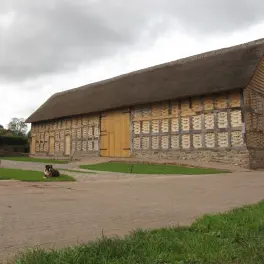History
Surrounded by Worcestershire most idyllic countryside rests one of England’s oldest historic Cruck timber frame buildings, Parsons Hall Farm, dating back to before 1304, the house has seen many historic events, in 1302 Edward II came to throne, the black death in 1346, War of the Roses 1455, Guy Fawkes and The Gunpowder Plot in 1605, and more recently both World Wars in 1914 and 1939.
Formerly called the Parsonage, where the parson of St Marys church resided, it is said there was once a path that led from the house to the church, the farmhouse has also been a school in the early 18 century.
Parsons Hall Farm is a Grade II Listed farmhouse., formerly the Parsonage, an early C14 Timber-framed with rendered infill panels, the farmhouse is a Cruck Hall house of four cruck-framed bays aligned roughly north/south with large inserted chimney at north end of central bay, with later mid 19C additions. The brick thatch line around the main chimney, gave permission for the farmhouse to reinstate the thatched roof and a 21C Cruck extension was added to gain a bathroom on the first floor.
The farmhouse has a detached (attached) kitchen, possible the only one standing in Worcestershire, C17 and Grade II Listed, with a timber-frame, rendered infill panels and thatched roof, the interior of the bread oven is creatively bricked with outer stone facing, the stacked stone chimney has stone tiles to the circular bread oven situated at south end. These detached kitchens were built to keep the smells of the kitchen outside the house, but mainly to reduce the risk of fire to the main property.
Adjacent is the original Tithe Barn C17 with woven oak panels and long straw thatched roof tithes were payments in kind such as crops, wool, milk etc, comprising an agreed proportion of the yearly profits of cultivation or farming, and made by parishioners to support their parish church and its clergy. Tithe barns were usually associated with the village church or rectory where independent farmers took their tithes
The Tithe Barn Is Grade II Listed, during 2010 the tithe barn went through extensive restoration, the stone bays and absent beams were reinstated, the old rusty tin roof removed and replaced with the original material of a long straw thatch, with several woven oak panels remaining, gave the pattern to reinstate the absent panels, these panels offered shelter to the crops stored, also let in air, so the crops didn’t perish.
The individual stone bays offered a thrashing area in times gone by, the centre cobbled ‘Drive Through’ leads down to the cart pond, enabling the metal rims of the wheels of the carts to cool and contracted back onto the timber wheels.
Hand laid cobbles surrounding the Tithe Barn, with some recent repair work, uncovered evidence of the original stone gullies, which have since been reinstated.
All three buildings along with the surrounding livestock buildings and grounds were in a desperate state of repair when the estate was purchased in 2000 by the recent owners, over the years they have entirely and sympathetically restored the entirety using traditional skills carefully balanced to combine up-to-date and environmentally friendly facilities giving heat and hot water via a ground source heat pump and having its own bore hole for fresh spring water and the later addition of covering the livestock buildings with solar panels.






